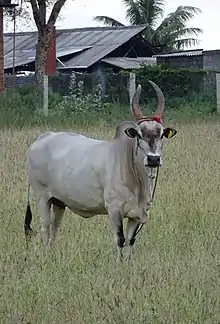Kangayam cattle
The Kangayam or Kangeyam is an Indian breed of draught cattle from the state of Tamil Nadu, in South India.[3]: 211 Its area of origin is Kongu Nadu, the region surrounding Coimbatore, close to the border between Tamil Nadu and Kerala,[4]: 214 but it is distributed over a considerably wider area.[5]: 410 The breed name derives from that of the town of Kangeyam.[6] It may also be called Kanganad or Kongu.[2]
 Cow | |
 Bull | |
| Conservation status | |
|---|---|
| Other names |
|
| Country of origin | India |
| Traits | |
| Weight | |
| Height | |
| Coat | grey, darker in bulls |
| Horn status | horned |
| |
History

The Kangayam is a traditional draught breed of Tamil Nadu. It is not closely related to the other draught breed of the state, the Umblachery, but may have some influence from the Ongole.[4]: 214 [3]: 211 Its area of origin is the region surrounding Coimbatore, close to the border between Tamil Nadu and Kerala,[4]: 214 but it is distributed over a considerably wider area;[5]: 410 the name of the breed derives from that of the taluk of Kangeyam in Tiruppur District.[6]
In 1996 there were 479000 of the cattle;[4]: 214 in 2022 a total population of between 127500 and 152500 head was reported to DAD-IS.[2]
It has been exported to Brazil, where it is called the Cangaian.[7]
Characteristics
The Kangayam is of medium size, with a height at the withers of some 125–140 cm and a body weight of 340–525 kg;[2] two body types are described, a larger and a smaller.[4]: 214
The calves are red when born, but change to grey by the age of two; cows are grey or dark grey, bulls are darker and may be black on the head and foreparts. The colour of cows and oxen fades as they age, and cows may become completely white.[4]: 214
Use
The Kangayam was one of the two principal draught breeds used in Tamil Nadu, the other being the Hallikar. The cows give little milk: annual yield is in the range 342–1455 kg, with an average of 540 kg; the fat content is approximately 3.9%.[4]: 214
Bulls are used in traditional bull races, as are Hallikar and Ongole bulls.[4]: 214 They are also commonly used in the traditional sport of Jallikattu.[6][8]
References
- Barbara Rischkowsky, Dafydd Pilling (editors) (2007). List of breeds documented in the Global Databank for Animal Genetic Resources, an annex to The State of the World's Animal Genetic Resources for Food and Agriculture. Rome: Commission on Genetic Resources for Food and Agriculture, Food and Agriculture Organization of the United Nations. ISBN 9789251057629. Archived 23 June 2020.
- Breed datasheet: Kangayam / India (Cattle). Domestic Animal Diversity Information System of the Food and Agriculture Organization of the United Nations. Accessed January 2021.
- N.R. Joshi, Ralph W. Phillips (1953). Zebu Cattle of India and Pakistan. FAO Agriculture Studies No. 19. Rome: Food and Agriculture Organization of the United Nations.
- Valerie Porter, Lawrence Alderson, Stephen J.G. Hall, D. Phillip Sponenberg (2016). Mason's World Encyclopedia of Livestock Breeds and Breeding (sixth edition). Wallingford: CABI. ISBN 9781780647944.
- Marleen Felius (1995). Cattle Breeds: An Encyclopedia. Doetinchem, Netherlands: Misset. ISBN 9789054390176.
- Animal Husbandry: Kangayam Cattle. Tiruppur District Administration. Accessed June 2022.
- Breed data sheet: Cangaian / Brazil (Cattle). Domestic Animal Diversity Information System of the Food and Agriculture Organization of the United Nations. Accessed January 2021.
- L. Rajagopal (14 January 2018). Tamil Nadu: Bull dose Jallikattu revives Kangeyam popularity. New Indian Express. Accessed June 2022.